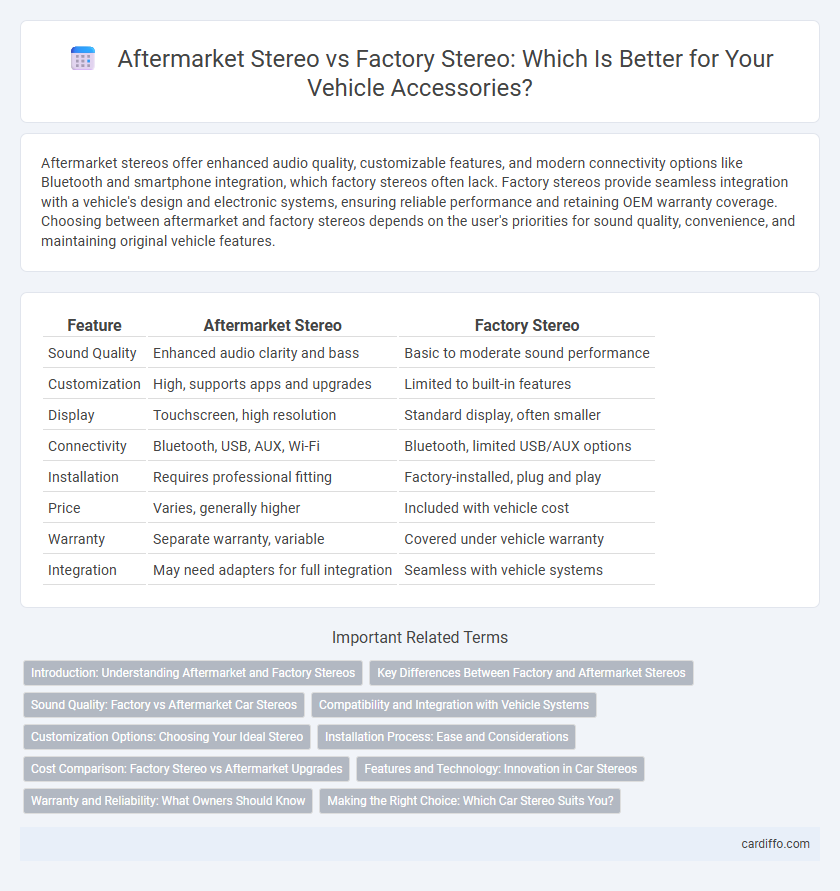Aftermarket stereos offer enhanced audio quality, customizable features, and modern connectivity options like Bluetooth and smartphone integration, which factory stereos often lack. Factory stereos provide seamless integration with a vehicle's design and electronic systems, ensuring reliable performance and retaining OEM warranty coverage. Choosing between aftermarket and factory stereos depends on the user's priorities for sound quality, convenience, and maintaining original vehicle features.
Table of Comparison
| Feature | Aftermarket Stereo | Factory Stereo |
|---|---|---|
| Sound Quality | Enhanced audio clarity and bass | Basic to moderate sound performance |
| Customization | High, supports apps and upgrades | Limited to built-in features |
| Display | Touchscreen, high resolution | Standard display, often smaller |
| Connectivity | Bluetooth, USB, AUX, Wi-Fi | Bluetooth, limited USB/AUX options |
| Installation | Requires professional fitting | Factory-installed, plug and play |
| Price | Varies, generally higher | Included with vehicle cost |
| Warranty | Separate warranty, variable | Covered under vehicle warranty |
| Integration | May need adapters for full integration | Seamless with vehicle systems |
Introduction: Understanding Aftermarket and Factory Stereos
Aftermarket stereos offer enhanced audio features, customization options, and connectivity compared to factory stereos, which are designed to meet basic OEM specifications and maintain vehicle warranty. Factory stereos provide seamless integration with the vehicle's existing electronics and controls but often lack advanced functionalities found in aftermarket systems. Understanding these differences helps consumers make informed decisions about upgrading their car audio experience.
Key Differences Between Factory and Aftermarket Stereos
Factory stereos are designed specifically for a vehicle's make and model, offering seamless integration with existing controls and electronics but often lack advanced features and customization options. Aftermarket stereos provide enhanced audio quality, modern connectivity such as Bluetooth, smartphone integration, and customizable equalizers, but installation may require additional adapters or modifications. The choice between factory and aftermarket stereos depends on the user's preference for convenience and compatibility versus upgraded performance and features.
Sound Quality: Factory vs Aftermarket Car Stereos
Aftermarket car stereos typically deliver superior sound quality compared to factory stereos due to advanced audio components, customizable equalizers, and higher wattage amplifiers. Factory stereos often have limited audio fidelity and basic sound processing, constrained by vehicle manufacturer specifications and cost considerations. Upgrading to an aftermarket stereo enhances clarity, bass response, and overall listening experience tailored to user preferences.
Compatibility and Integration with Vehicle Systems
Aftermarket stereos often offer broader compatibility with various audio formats and advanced features, but may encounter challenges integrating seamlessly with a vehicle's existing systems like steering wheel controls, backup cameras, or onboard diagnostics. Factory stereos are specifically designed for full integration with the car's electronics, ensuring optimal communication with vehicle sensors and controls while maintaining warranty agreements. Choosing between aftermarket and factory stereos requires evaluating the trade-off between enhanced features and guaranteed system cohesion.
Customization Options: Choosing Your Ideal Stereo
Aftermarket stereos offer extensive customization options, including enhanced sound quality, touchscreen interfaces, and compatibility with various apps and devices, catering to personalized audio experiences. Factory stereos provide basic, vehicle-specific features with seamless integration and warranty coverage but often lack advanced customization and modern technology. Selecting your ideal stereo depends on prioritizing either tailored features and upgrades with aftermarket options or reliability and fitment from factory systems.
Installation Process: Ease and Considerations
Aftermarket stereo installation often requires additional wiring, mounting brackets, and possible modifications to the vehicle's dashboard, demanding technical knowledge or professional assistance for seamless integration. Factory stereos, designed specifically for the vehicle, offer plug-and-play installation with straightforward integration into existing car systems, minimizing installation time and complexity. Considerations include compatibility with vehicle electronics, potential need for adapter harnesses, and preserving factory warranty when opting for aftermarket options.
Cost Comparison: Factory Stereo vs Aftermarket Upgrades
Aftermarket stereo systems generally offer a wider range of features and superior sound quality compared to factory stereos, but they come at a higher upfront cost, often ranging from $200 to $1,500 depending on brand and installation complexity. Factory stereos are typically included in the vehicle purchase price or available as cheaper upgrades, costing between $100 and $500, but they usually lack advanced audio components and customization options. When comparing cost-effectiveness, aftermarket upgrades may provide better long-term value through enhanced audio performance and expandability despite the initial investment.
Features and Technology: Innovation in Car Stereos
Aftermarket stereos offer advanced features such as touchscreen interfaces, smartphone integration, and enhanced audio processing technologies that often surpass factory stereo capabilities. Factory stereos provide seamless integration with vehicle controls and safety systems but may lack the latest innovation found in aftermarket models. Innovations in car stereos include voice command functionality, customizable equalizers, and support for emerging audio formats, driving the rapid evolution of in-car entertainment technology.
Warranty and Reliability: What Owners Should Know
Aftermarket stereos often come with separate warranties ranging from one to three years, while factory stereos typically maintain the vehicle's original warranty coverage, ensuring comprehensive reliability. Installation quality significantly impacts the reliability of aftermarket units, and improper setup can void certain aspects of the vehicle's warranty. Owners should verify compatibility and warranty terms with both the manufacturer and installer to avoid unexpected costs and maintain long-term performance.
Making the Right Choice: Which Car Stereo Suits You?
Choosing between an aftermarket stereo and a factory stereo depends on your audio preferences, budget, and installation complexity. Aftermarket stereos offer enhanced sound quality, customizable features, and compatibility with the latest smartphone integrations, while factory stereos maintain original vehicle aesthetics and easier integration with existing controls. Evaluating your priorities, such as advanced audio settings or seamless factory integration, helps determine which car stereo suits your driving experience best.
Aftermarket Stereo vs Factory Stereo Infographic

 cardiffo.com
cardiffo.com